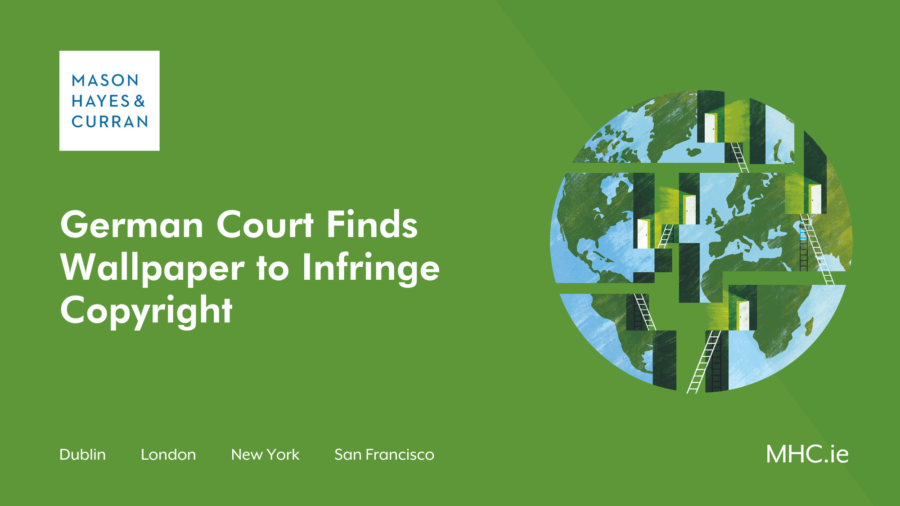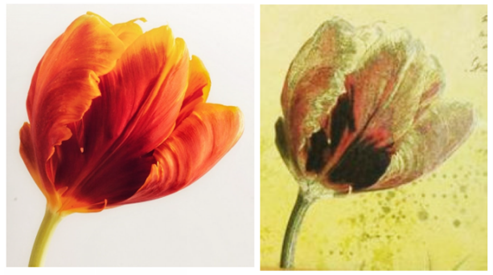German Court Finds Wallpaper to Infringe Copyright

A defendant who purchased wallpaper online has been found guilty of copyright infringement by a German court after posting images online of her holiday home featuring the wallpaper. Head of Intellectual Property, Gerard Kelly considers the findings of this case and how a similar scenario, if it were to arise, may be interpreted by the courts in Ireland.
In August 2022, a district court in Germany found that the use of wallpaper can infringe an individual’s copyright. A case was brought before the court in Germany in which the plaintiff alleged to be the owner of a number of tulip images. The plaintiff had entered a license agreement with N GmbH, granting N GmbH a ‘simple right of use’ to the tulip images. N GmbH turned the images into wallpaper which was subsequently sold to the defendant via an online store. The defendant used the wallpaper to decorate her holiday apartment. Photos of the decorated apartment were then posted on her website and several booking portals.
The plaintiff claimed that although they had entered a license agreement with N GmbH, N GmbH never sold the rights to use the images to third parties, but they had merely sold the image as a wallpaper to the defendant. The defendant claimed that as it had purchased the wallpaper, it was not subject to any restrictions on its disposal. The defendant claimed she had legitimately acquired the wallpaper and was therefore allowed to use it on her premises. She claimed that the wallpaper was offered exclusively for this purpose and that was the use she ultimately put it to.

The plaintiff’s photograph (left), and N GmbH’s wallpaper (right)
Authorship
The defendant claimed that the plaintiff did not actually own the copyright in the photographs of the tulip. However, the German court held that whoever is designated as the author or photographer of a work is regarded as the author/photographer until the contrary is proven. The court was satisfied that the plaintiff had been expressly identified with his name as the author of the tulip photos and that the defendant had failed to disprove the presumption of authorship.
Rights of use
The court acknowledged that had the plaintiff relinquished all rights to the images, i.e., by an exclusive license or assignment to N GmbH, then the plaintiff would have lost its entitlement to make the claim for copyright infringement. Instead, only a ‘simple right of use’, in other words, a partial license had been entered between the parties.
The court found that by posting the photos of the wallpaper on her website and booking portals, the defendant reproduced the plaintiff’s works and made them publicly accessible within the meaning of the German Copyright Act. The court found that this use was infringing as the defendant failed to prove she had acquired the necessary rights of use. There was no written or verbal agreement between the parties which granted the defendant a right of use in this way. While the defendant exhibited her invoice for the wallpaper, it simply stated the purchase price for the wallpaper and did not stipulate any transfer of copyright usage rights. The court acknowledged that an implied granting of rights is possible, but that did not arise in this case on the facts.
In considering the overall facts of the case, the court found that it could not be assumed that the defendant had been granted the right to use the wallpaper for reproduction or public access. Under German law, if the types of use of a work are not expressly specified when granting a right of use or license, the types of use which are allowed are determined in accordance with the contractual purpose that exists between the parties. If there is any doubt as to rights of use, it is understood that the rights of use will only extend to the purpose that the contract absolutely requires. When the wallpaper was sold to the defendant, no transfer of the right of use was absolutely necessary. The defendant’s intended use was to stick the wallpaper onto her premises. The court considered that such an action did not affect the exploitation rights that were reserved for the author.
Incidental use
The court considered whether the use of the wallpaper in the photo on the website and booking portals could be considered merely incidental in relation to the actual subject matter being reproduced. There is an equivalent exception available in Ireland under the Copyright and Related Rights Act 2000 (as amended). The court identified that it is the view of an objective average observer that must be taken into consideration when deciding whether the use of a copyrighted work is solely incidental.
The court found that the wallpaper images in question could not be regarded as incidentally used as the wallpaper created a recognisable mood for the advertised room. The wallpaper was held to be a central element in the room design and was prominently placed on the back wall, making up the main part of the photographs. A similar result was seen in the UK case of Football Association Premier League v Panini UK Ltd[1]. In that case, the Court of Appeal considered whether the use of logos in photographs on stickers and sticker albums could be regarded as incidental use. The court decided it was necessary to consider the reasons why the work had been included in another and ultimately, the inclusion of the work cannot be considered ‘incidental’ where its inclusion is ‘essential to the object for which the image’ was created. A similar approach, of considering the intention and prominence of the work in another, is likely to be followed here in Ireland.
Conclusion
The court ultimately found that the defendant had violated the plaintiff’s rights by reproducing and making available the copyrighted images of the tulip in the form of the wallpaper via her website and the booking portals. While this decision was reached by a German court and in accordance with German law, it is interesting to consider whether a similar conclusion could be reached by an Irish court and under Irish copyright law given there are many similar respects between the two countries’ legislation.
Particularly, it has yet to be seen how the Irish courts would approach a similar dispute where there is a sale to a third party from another who only holds a partial license to the copyrighted work. The German copyright act stipulates that ‘if the types of use were not specifically designated when a right of use was granted, the types of use to which the right extends is determined in accordance with the purpose envisaged by both parties to the contract.’ There is no equivalent in Irish law. Therefore, only time will tell whether the Irish courts would find in favour of a copyright owner or a bona fide purchaser, if faced with a similar scenario.
For more information on protecting your brand and related intellectual property rights, contact a member of our Intellectual Property team.
The content of this article is provided for information purposes only and does not constitute legal or other advice.
[1] [2004] FSR 1
Share this:



